Finite Element Simulation Tests of the Structural Strength of the Molding Module for Burger Production from Vegetable Outgrades
Abstract
1. Introduction
2. Materials and Methods
- (a)
- One dimension:
- beam elements of the BEAM type and rod elements of the ROD type for modeling pneumatic cylinders and
- RBE2 rigid elements for modeling point welds and other connections that facilitate load transfer between elements;
- (b)
- Two dimensions: plate-shell modeling of the surface of sheet metal structures;
- (c)
- Three dimensions: tetrahedral [30] (tetrahedral) finite elements for modeling the sliding elements, die assembly, dispenser runners, and pushers.
- Blockage of the horizontal dispenser pusher against the vegetable mixture accumulated in the chamber and the resulting pressure on the vegetable mixture;
- Blockage of the vertical dispenser pusher against the vegetable mixture accumulated in the chamber and the resulting pressure on the vegetable mixture;
- Locking of the die assembly in the runners during an attempt to shift the die;
- Accidental collision of the ejector with the die assembly, with the force generated by the actuator amounting to 300 N for a piston diameter of 25 mm.
- P is the working pressure (Pa);
- F is the thrust force (N);
- A is the surface area (m2);
- D is the piston diameter (m).
2.1. Assumptions of Safety Indicators
2.2. Calculation Model of the Molding Module
- Blockage of the pusher of the horizontal dispenser. The pusher is pushed by the actuator, and the large amount of mixed vegetable mix prevents it from shifting in the sleeve (Figure 10a). The red line shown in the figure shows that, as a result of the pusher action, the vegetable mix is pressed against the wall of the vertical dispenser (RBE2 rigid element). In this simplification of the calculation model, the compressibility of the mixture was omitted.
- Blockage of the pusher of the vertical dispenser (Figure 10b).
- Locking of the die assembly in the runners (Figure 10c).
- Accidental collision of the ejector with the die assembly (Figure 10d).
3. Results and Discussion
3.1. Case 1. The Pusher of the Horizontal Dispenser Was Blocked
3.2. Case 2. The Pusher of the Vertical Dispenser Was Blocked
3.3. Case 3. The Die Assembly Was Locked in the Runners
3.4. Case 4. The Ejector Collided Randomly with the Die Assembly
4. Conclusions
- The design of the device corresponds to the assumptions of the technological process, which consists of the processing of frozen vegetable outgrades;
- Strength analyses on a virtual CAD 3D model, allowed an innovative machine that reduces food waste to be designed;
- The results of strength analyses confirmed that the permissible stress levels were not exceeded in the molding module.
Author Contributions
Funding
Institutional Review Board Statement
Informed Consent Statement
Data Availability Statement
Conflicts of Interest
References
- Zamri, G.B.; Azizal, N.K.A.; Nakamura, S.; Okada, K.; Nordin, N.H.; Othman, N.; MD Akhir, F.N.; Sobian, A.; Kaida, N.; Hara, H. Delivery, impact and approach of household food waste reduction campaigns. J. Clean. Prod. 2020, 246, 118969. [Google Scholar] [CrossRef]
- Li, H.; Pan, P. Food Waste in Developed Countries and Cold Chain Logistics. E3S Web Conf. 2021, 251, 8. [Google Scholar] [CrossRef]
- Calvo-Porral, C.; Medín, A.F.; Losada-López, C. Can Marketing Help in Tackling Food Waste?: Proposals in Developed Countries. J. Food Prod. Mark. 2017, 23, 42–60. [Google Scholar] [CrossRef]
- Jellil, A.; Woolley, E.; Rahimifard, S. Towards integrating production and consumption to reduce consumer food waste in developed countries. Int. J. Sustain. Eng. 2018, 11, 294–306. [Google Scholar] [CrossRef]
- How to Avoid Food Waste—Strategies to Improve the Efficiency of the Distribution Chain in the EU in Terms of Donating Food to Charity. Available online: https://www.eca.europa.eu/Lists/ECADocuments/SR16_34/SR_FOOD_WASTE_EN.pdf (accessed on 12 October 2021).
- Yu, Y.; Jaenicke, E.C. Estimating Food Waste as Household Production Inefficiency. Am. J. Agric. Econ. 2020, 102, 525–547. [Google Scholar] [CrossRef]
- Frenkel, V.S.; Cummings, G.A.; Maillacheruvu, K.Y.; Tang, W.Z. Food-processing wastes. Water Environ. Res. 2020, 92, 1726–1740. [Google Scholar] [CrossRef]
- Hegde, S.; Lodge, J.S.; Trabold, T.A. Characteristics of food processing wastes and their use in sustainable alcohol production. Renew. Sustain. Energy Rev. 2018, 81, 510–523. [Google Scholar] [CrossRef]
- Del Rio Osorio, L.L.; Flórez-López, E.; Grande-Tovar, C.D. The potential of selected agri-food loss and waste to contribute to a circular economy: Applications in the food, cosmetic and pharmaceutical industries. Molecules 2021, 26, 515. [Google Scholar] [CrossRef] [PubMed]
- Bąkowski, H.; Stanik, Z.; Kubik, A.; Wieszała, R. Forecasting wear in a sliding association based on stress distributions and values using FEM (In Polish). TTS Tech. Transp. Szyn. 2016, 49. [Google Scholar]
- Magomedov, I.A.; Khaliev, M.S.U.; Elmurzaev, A.A. Application of Finite Element Analysis in medicine. J. Phys. Conf. Ser. 2020, 1679, 022057. [Google Scholar]
- Zhang, M.; Gong, H. Translation of engineering to medicine: A focus on finite element analysis. J. Orthop. Transl. 2020, 20, 1–2. [Google Scholar] [CrossRef]
- Gozar, H.; Chira, A.; Nagy, Ö.; Derzsi, Z. Medical Use of Finite Element Modeling of the Ankle and Foot. J. Interdiscip. Med. 2018, 3, 34–38. [Google Scholar] [CrossRef][Green Version]
- Joshi, K.D. Design and Analysis of High Pressure Extractor with Supercritical Fluid. IOSR J. Mech. Civil Eng. 2017, 17, 33–41. [Google Scholar] [CrossRef]
- Nguyen, H.; Nguyen, N.P.; Nguyen, X.Q.; Le, A.D. An Approach to Optimize the Design of Ultrasonic Transducer for Food Dehydration. Int. J. Adv. Sci. Eng. Inform. Technol. 2021, 11, 1125–1131. [Google Scholar] [CrossRef]
- Patel, J.G.; Panchal, M.B. Design analysis of rotary turret of poucher machine. Perspect. Sci. 2016, 8, 310–312. [Google Scholar] [CrossRef][Green Version]
- Zheng, F.; Zeng, L.; Lu, Y.; Kai, G. Strength study on screw assembly of food screw press based on FEA. Adv. J. Food Sci. Technol. 2015, 7, 187–190. [Google Scholar] [CrossRef]
- Rao, S.S. The Finite Element Method in Engineering; Elsevier: Amsterdam, The Netherlands, 2017. [Google Scholar]
- Mueller, D.W. An introduction to the finite element method using MATLAB. Int. J. Mech. Eng. Educ. 2005, 33, 260–277. [Google Scholar] [CrossRef]
- Matthews, F.L.; Davies, G.A.O.; Hitchings, D.; Soutis, C. Fundamentals of finite element analysis. In Finite Element Modelling of Composite Materials and Structures; Woodhead: Sawston, UK, 2000. [Google Scholar]
- Kao, Y.T.; Zhang, Y.; Wang, J.; Tai, B.L. Bending behaviors of 3D-printed Bi-material structure: Experimental study and finite element analysis. Addit. Manuf. 2017, 16, 197–205. [Google Scholar] [CrossRef]
- Stefanou, G.; Savvas, D.; Papadrakakis, M. Stochastic finite element analysis of composite structures based on material microstructure. Compos. Struct. 2015, 132, 384–392. [Google Scholar] [CrossRef]
- Bahei-El-din, Y.A. Finite element analysis of viscoplastic composite materials and structures. Mech. Compos. Mater. Struct. 1996, 3, 1–28. [Google Scholar] [CrossRef]
- Tehel, R.; Päßler, T.; Bergmann, M. Effective FE models for simulating the elasto-mechanical characteristics of forming machines. Int. J. Adv. Manuf. Technol. 2020, 106, 3505–3514. [Google Scholar] [CrossRef]
- Althammer, F.; Ruf, F.; Middendorf, P. Size optimization methods to approximate equivalent mechanical behaviour in thermoplastics. J. Comput. Des. Eng. 2021, 8, 170–188. [Google Scholar] [CrossRef]
- Stadnicki, J.; Tokarz, Z. Mesoscale finite element model for calculating deformations of laminate composite constructions. Adv. Mech. Eng. 2016, 8, 1–9. [Google Scholar] [CrossRef]
- Major, Š.; Cyrus, P.; Dostál, R. Finite element model of fatigue fracture of reciprocating screw in moulding machine. Int. J. Mech. 2017, 11, 1–5. [Google Scholar]
- Zhou, J.; Li, L.; Ng, M.C.; Lee, W.B. Effect of molding machine’s stiffness on the thickness of molded glass rings. Int. J. Appl. Glas. Sci. 2019, 10, 584–597. [Google Scholar] [CrossRef]
- Zaqy, S.Y.B.; Sara, F. Zulfikar Stress analysis of IBS molding machine. Int. J. Recent Technol. Eng. 2019, 8, 2427–2431. [Google Scholar]
- Ignasiak, Ł.; Woźniak, P.; Bieńczak, A. Building of calculation model and strength analysis by using finite element method on example of mold to foaming of cooling furniture. J. Res. Appl. Agric. Eng. 2020, 65, 4–8. [Google Scholar]
- Walczak, J. Engineering Fluid Mechanics; Poznań University of Technology: Poznań, Poland, 2012. (In Polish) [Google Scholar]
- Kołakowski, Z. Fundamentals of Strength and Stability of Composite Plate Structures; Wydawnictwo Politechniki Łódzkiej: Łódź, Poland, 2008. (In Polish) [Google Scholar]
- Marcinkiewicz, J.; Bieńczak, A.; Dembicki, D.; Dudziński, P.; Mac, J.; Szczepaniak, J. Strength analysis of insulated body with use of FEM. J. Res. Appl. Agric. Eng. 2015, 60, 44–49. [Google Scholar]
- Spadło, M.; Dembicki, D.; Woźniak, P.; Szczepaniak, J. Strength analysis by method of the finite elements in construction of spray sterilizer with restrictions of standard EN 13445-3. J. Res. Appl. Agric. Eng. 2016, 61, 97–103. [Google Scholar]
- Spadło, M.; Ignasiak, Ł.; Szczepaniak, J. FEM modeling of buildings for emptying and disinfecting municipal waste containers for the purpose of carrying out strength analyses. Tech. Rol. Ogrod. Leśna 2013, 3, 6–15. (In Polish) [Google Scholar]
- Geng, T.; Tu, W.-Q.; Liu, D.-D. Injection Mold Cavity Stiffness and Intensity Analysis Based on ANSYS Workbench and MOLDFLOW. In Proceedings of the 2nd International Conference on Electronic & Mechanical Engineering and Information Technology (EMEIT-2012), Shenyang, China, 7 September 2012. [Google Scholar]
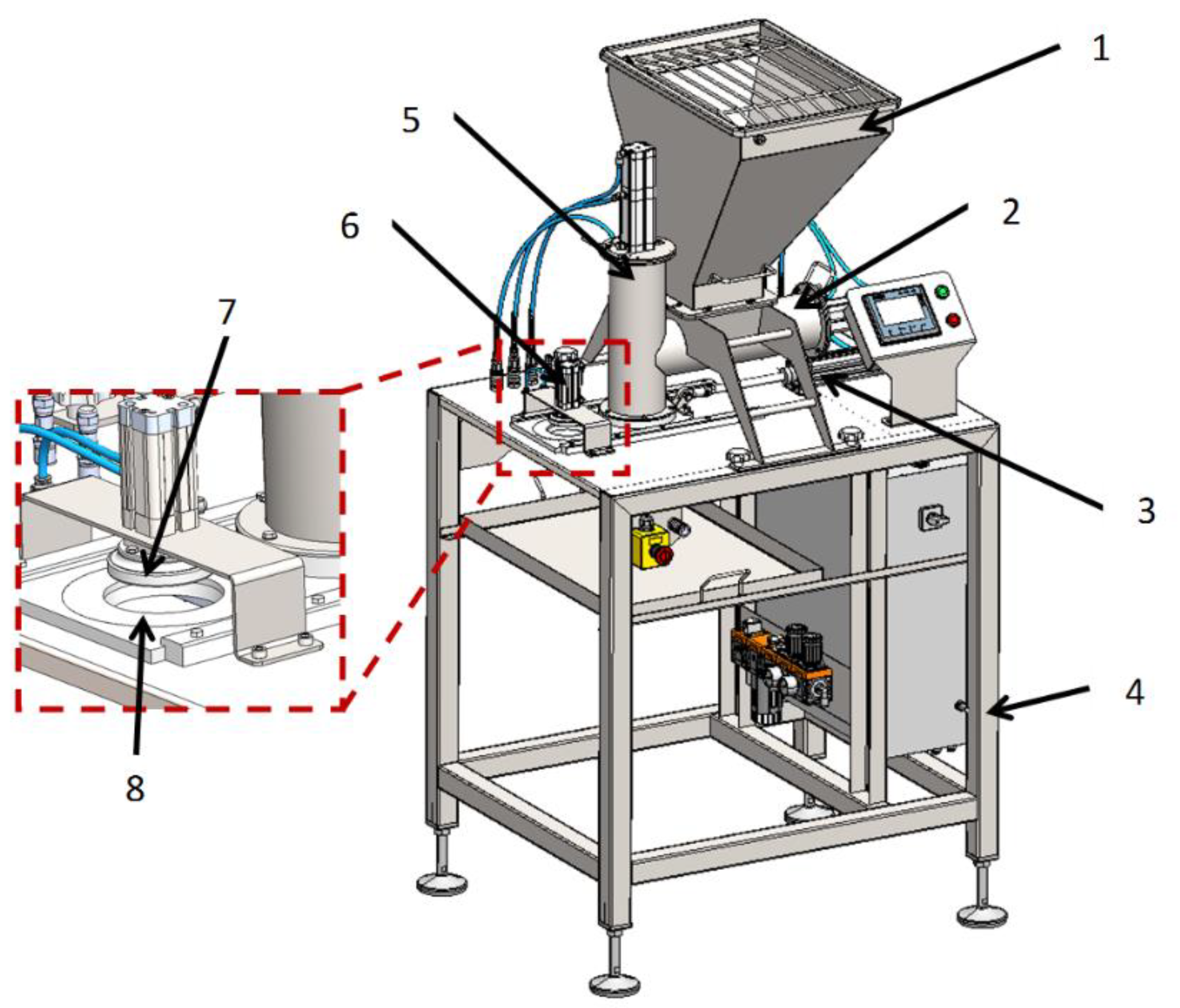
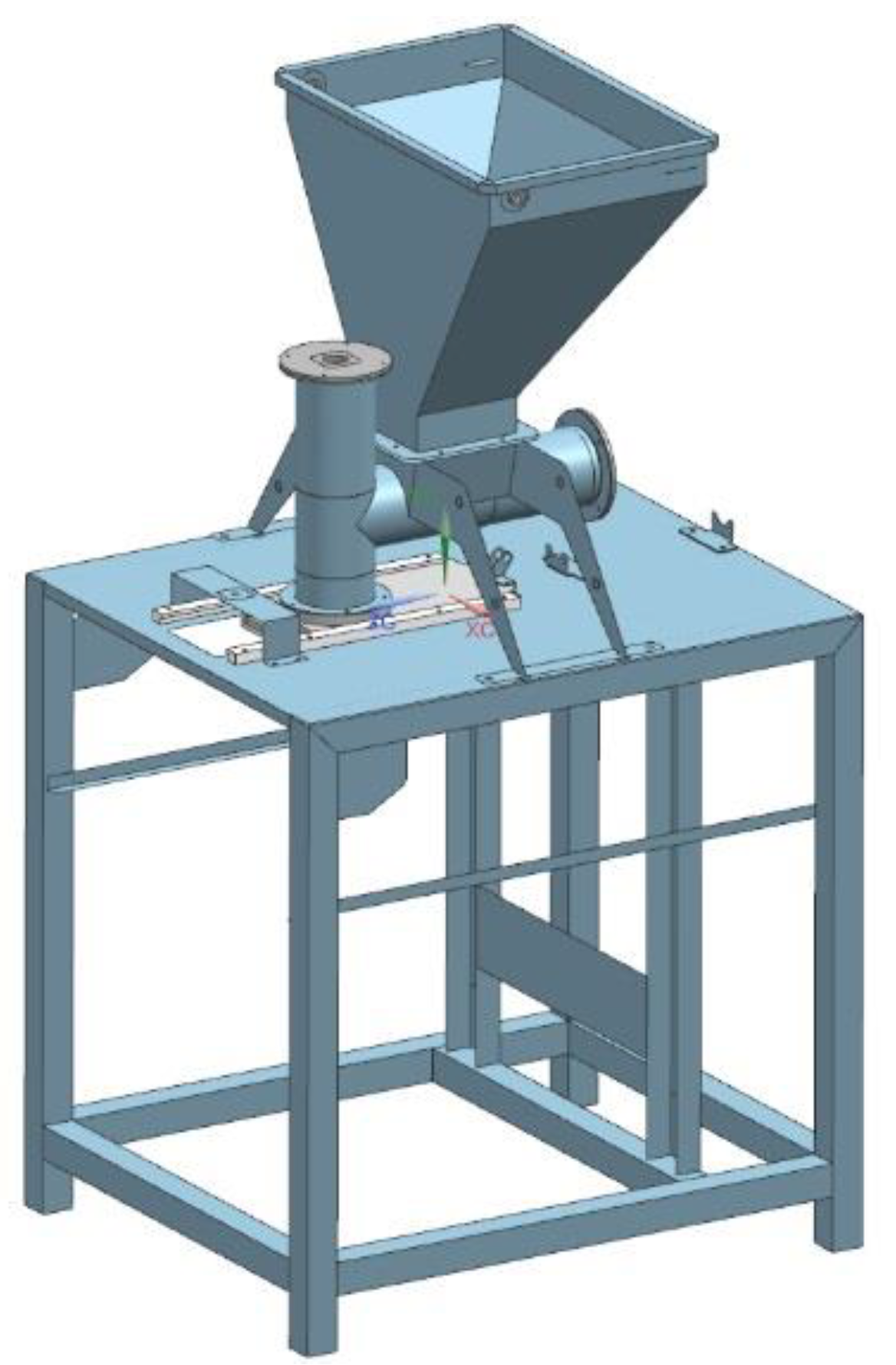
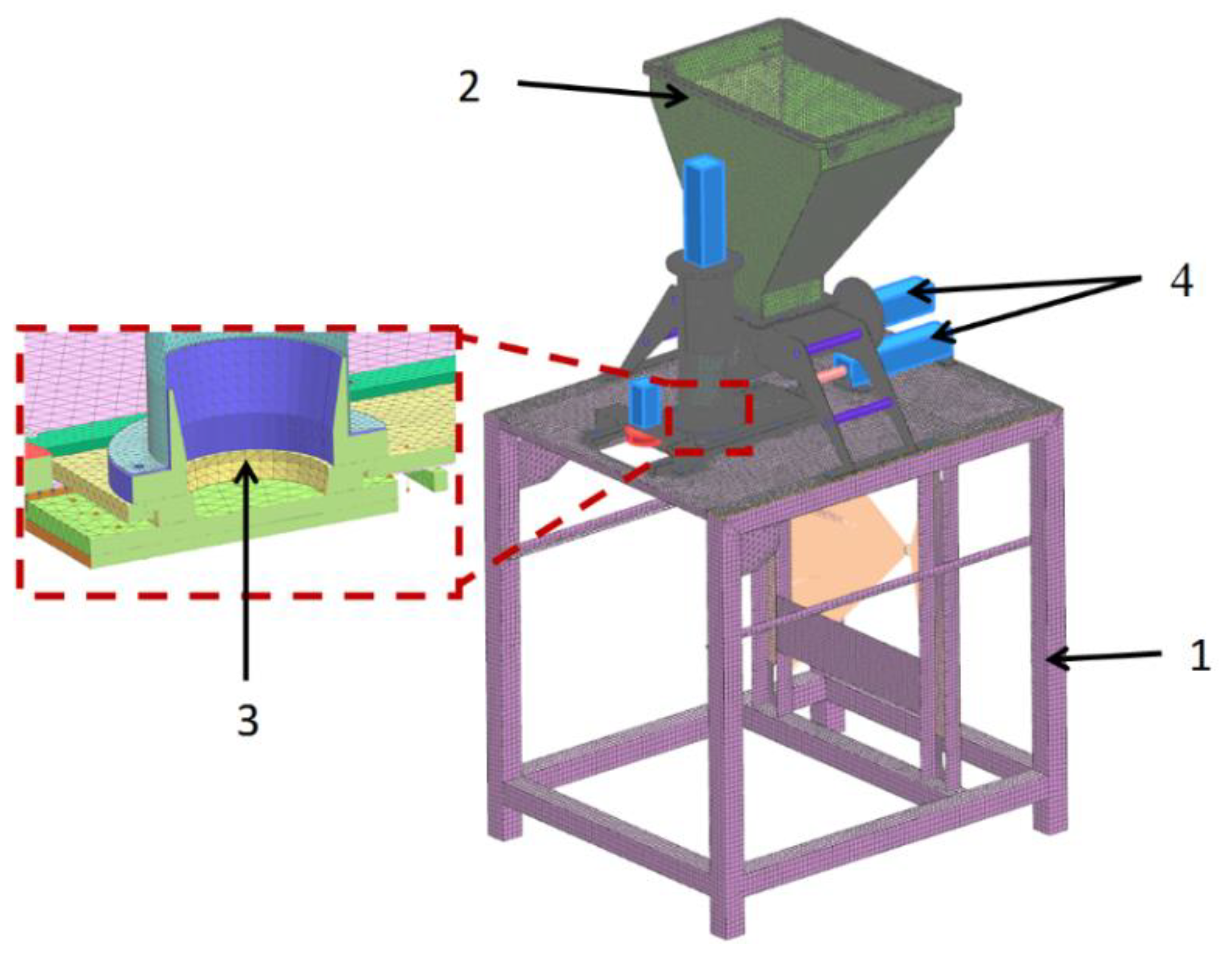
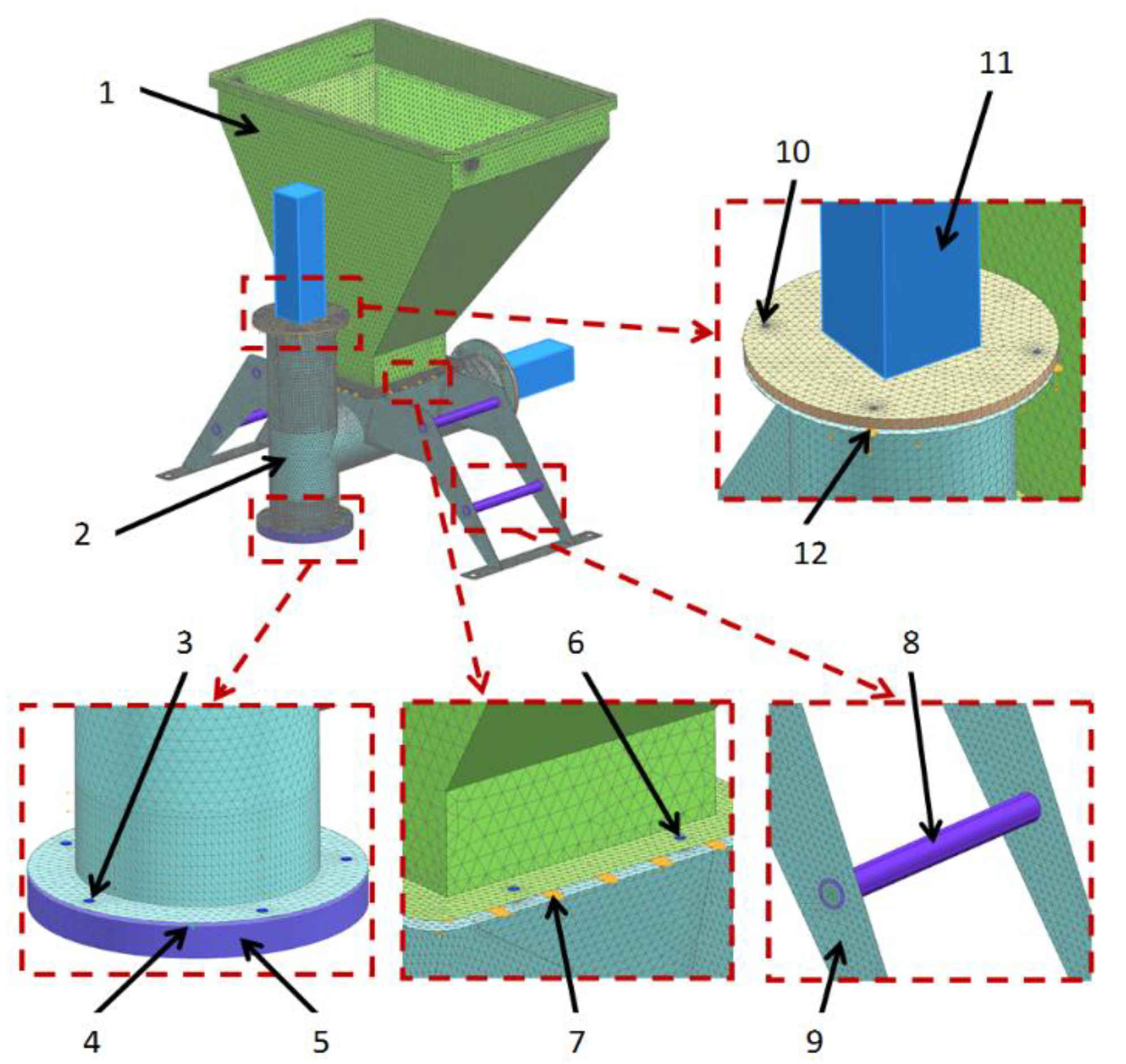
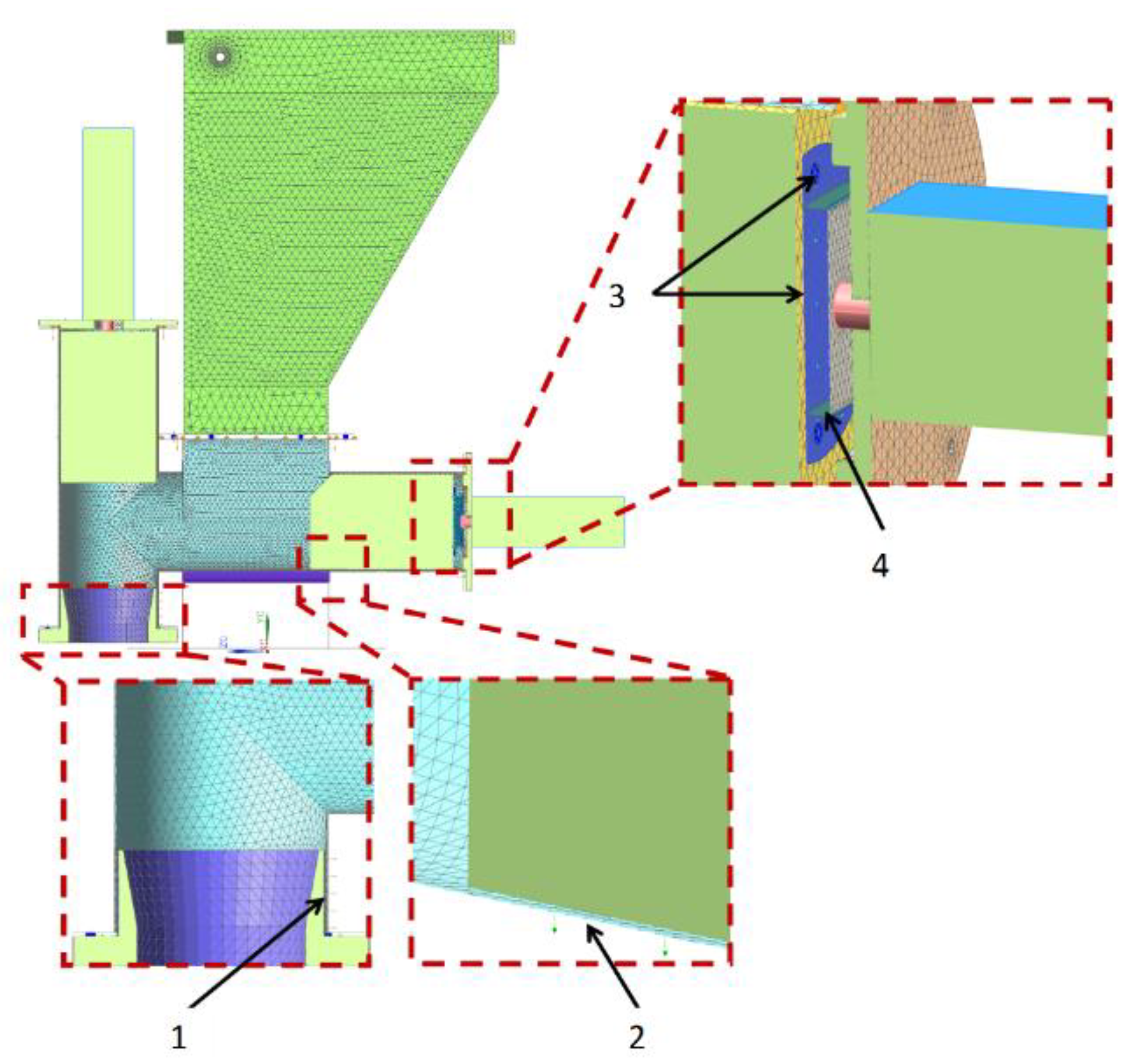
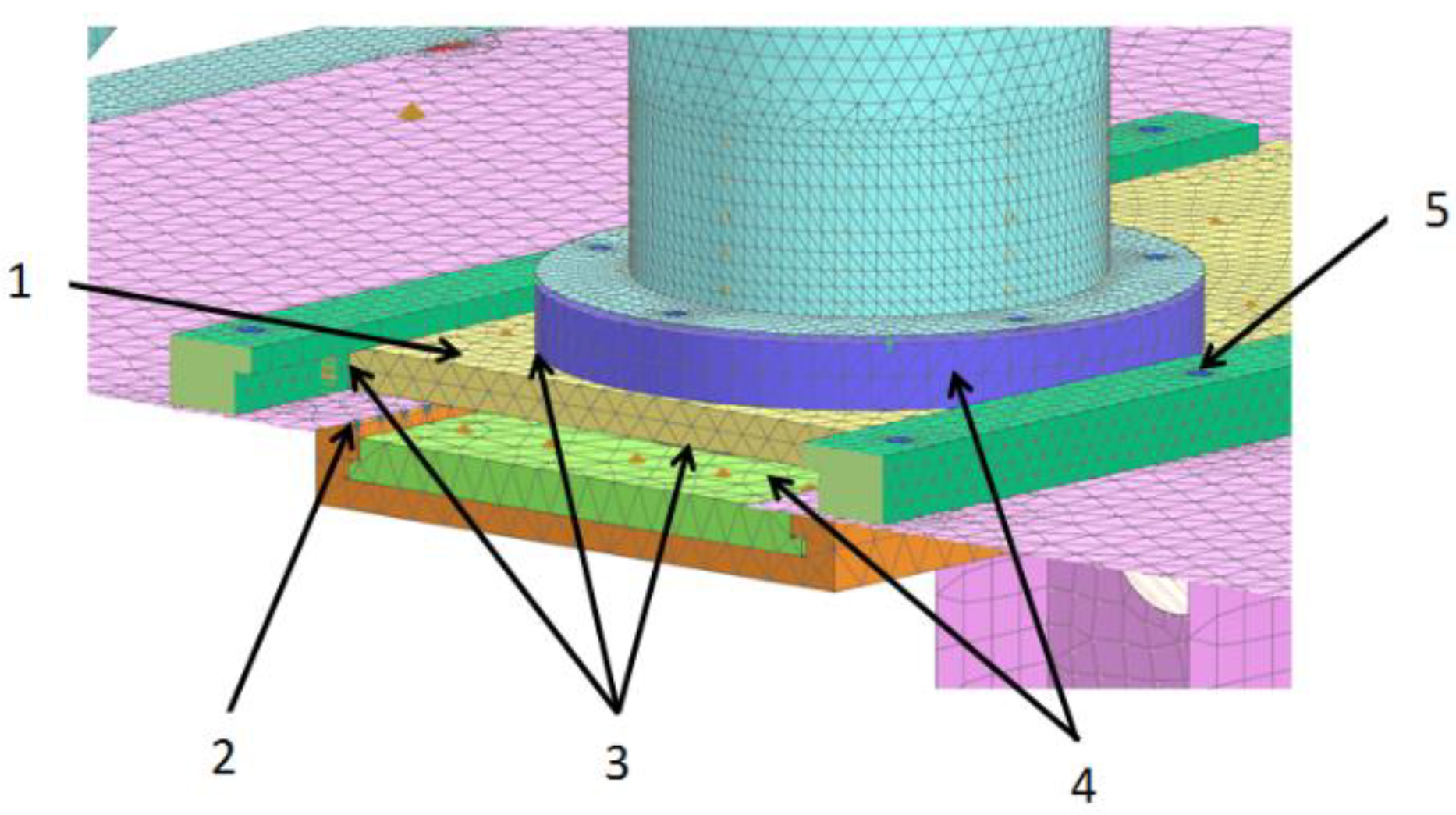
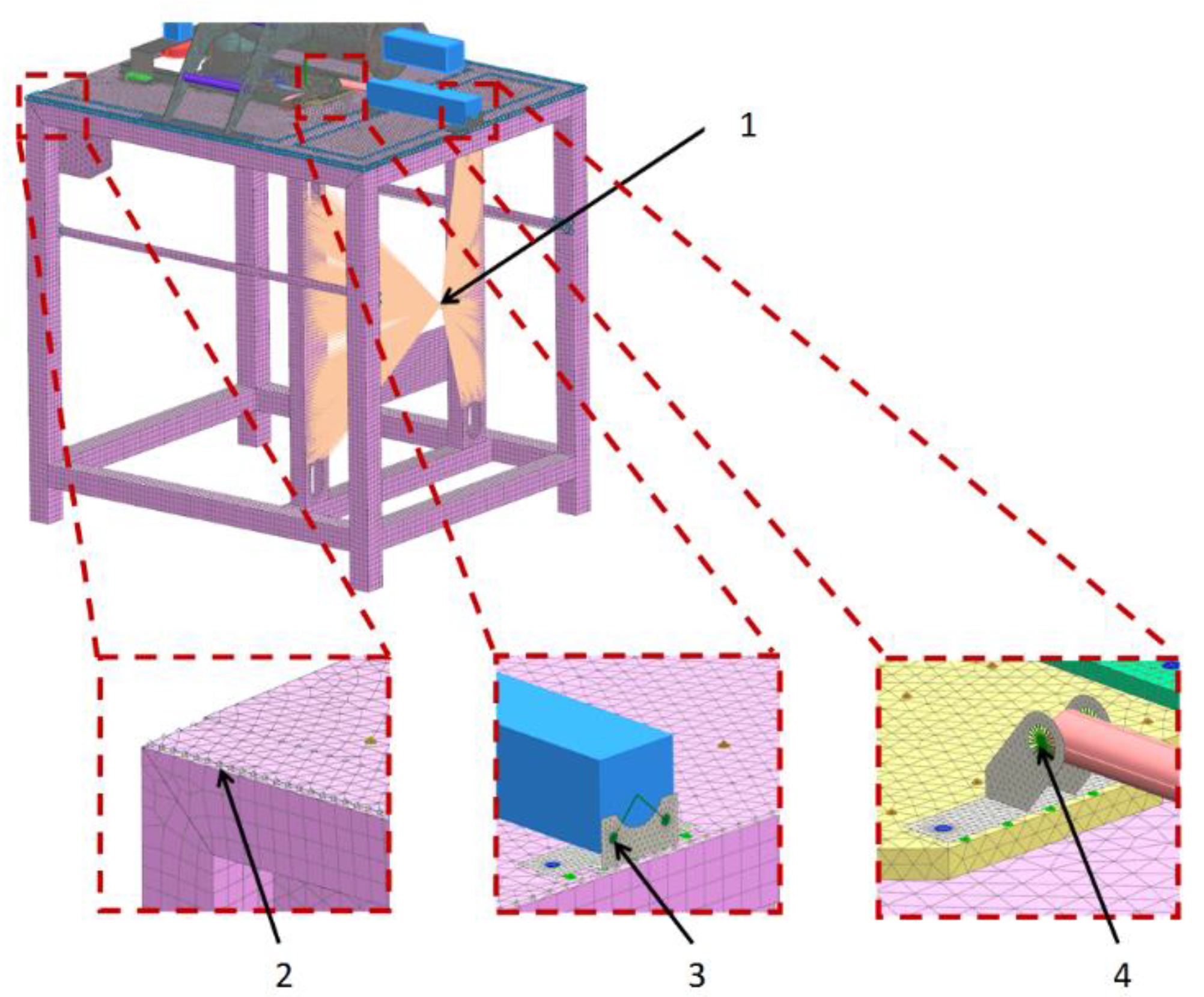
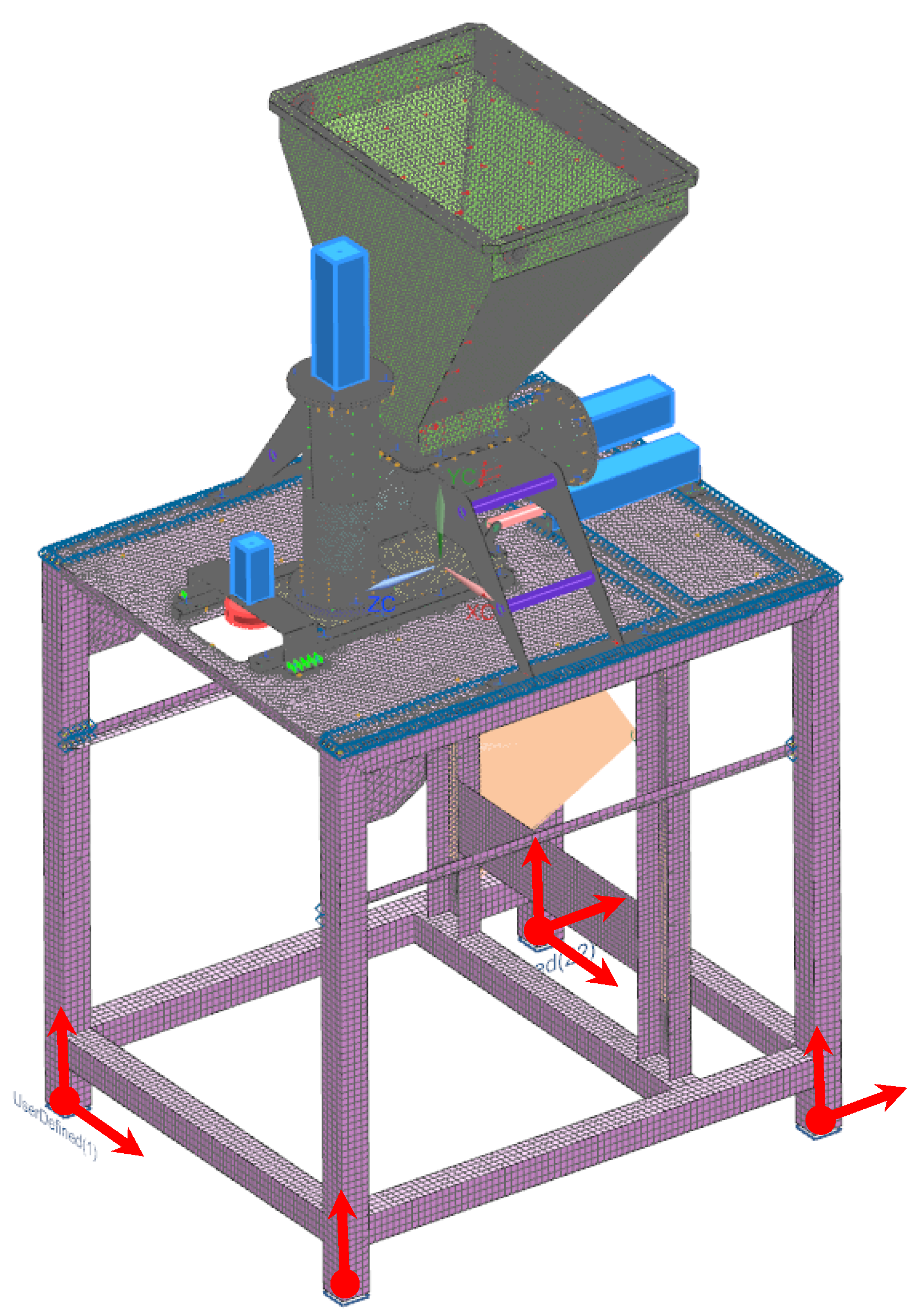


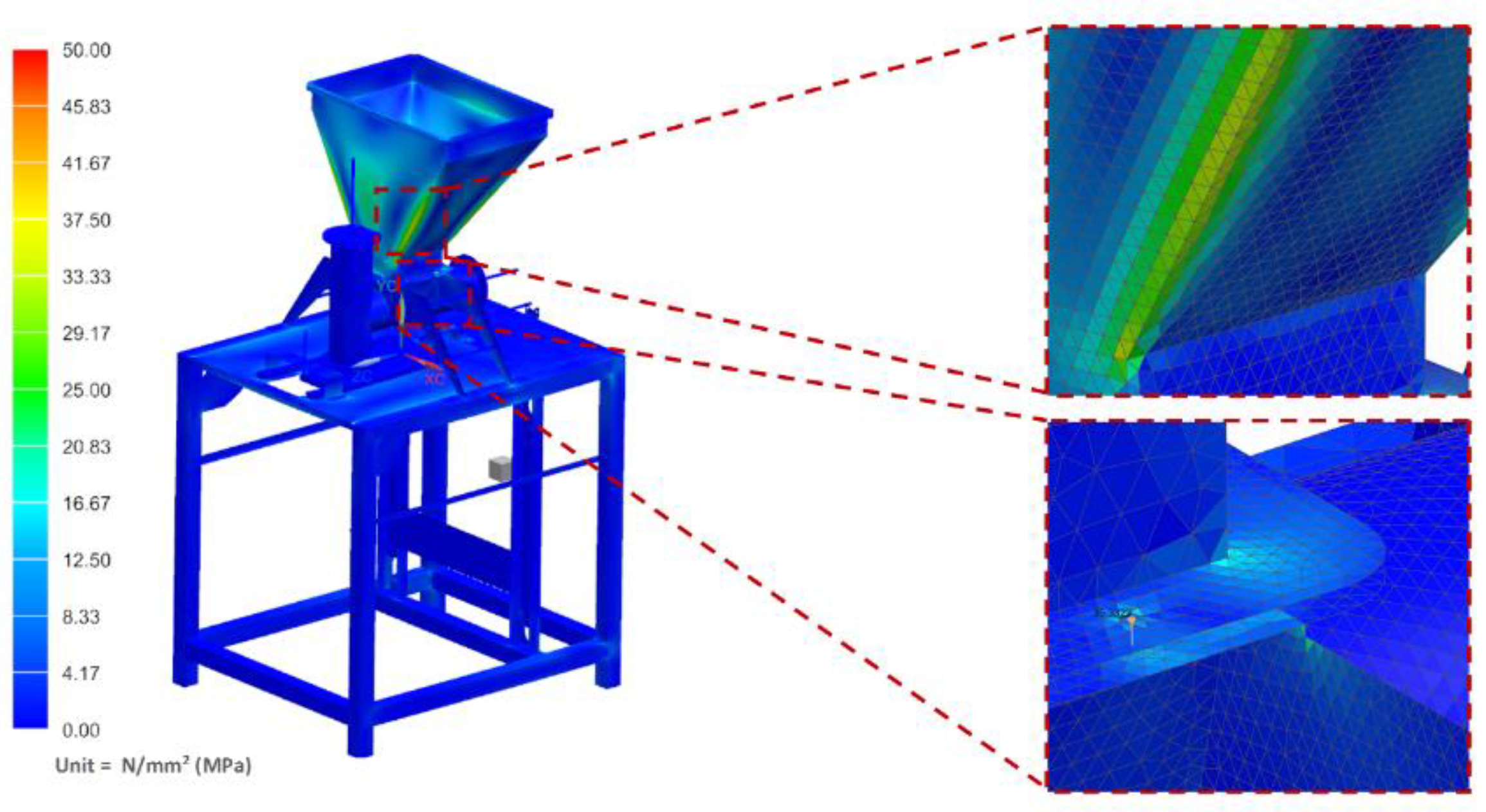
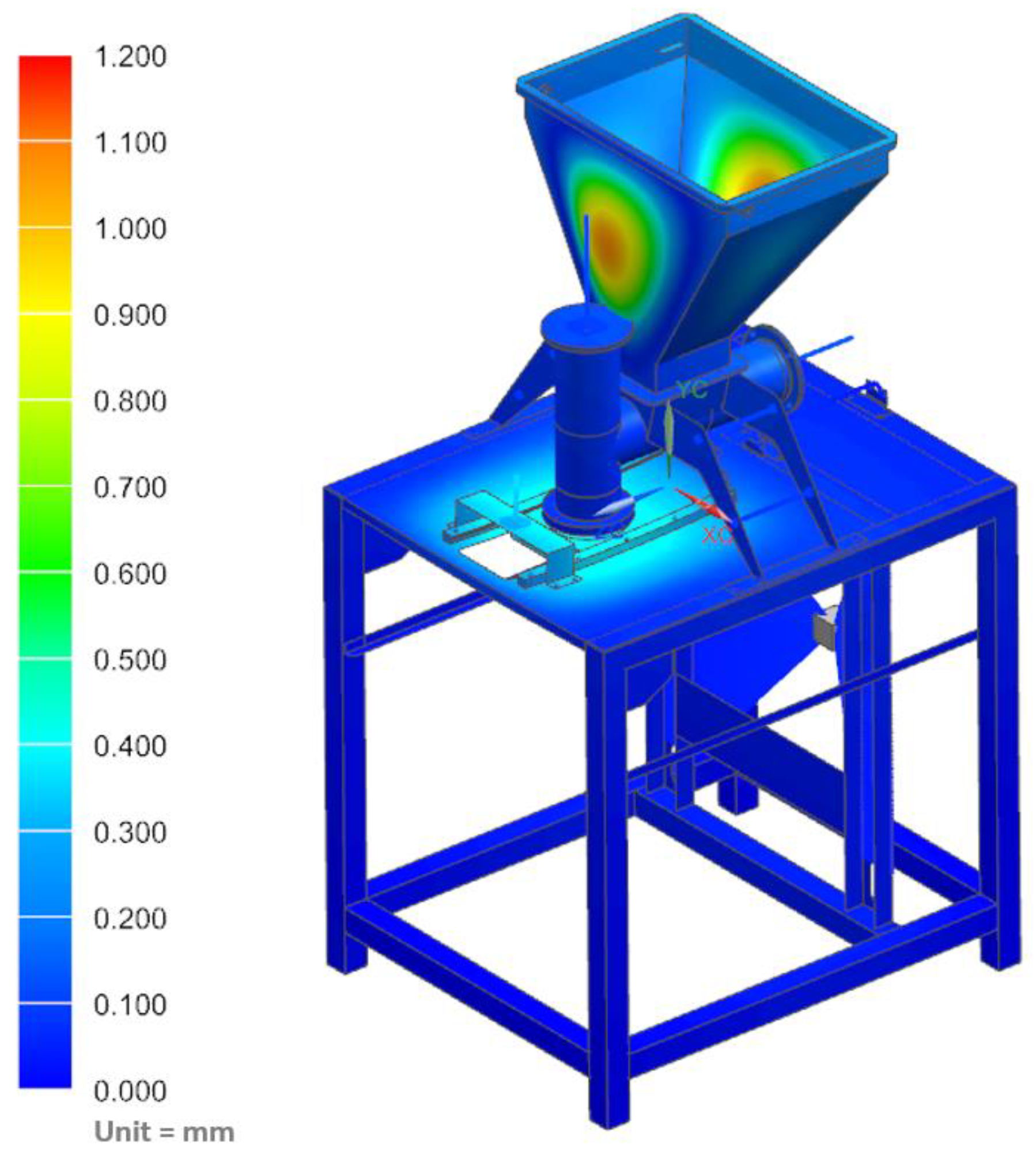
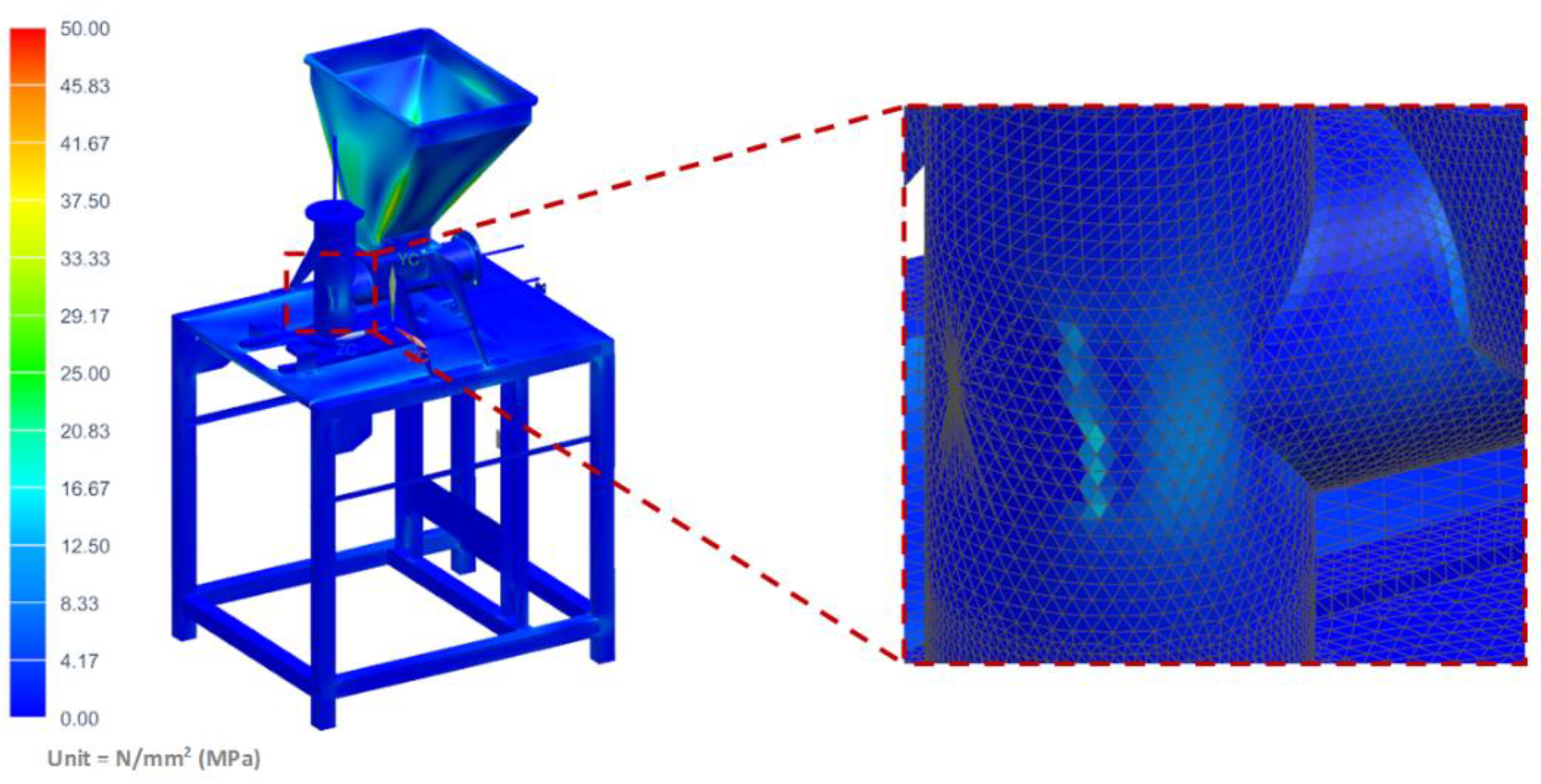

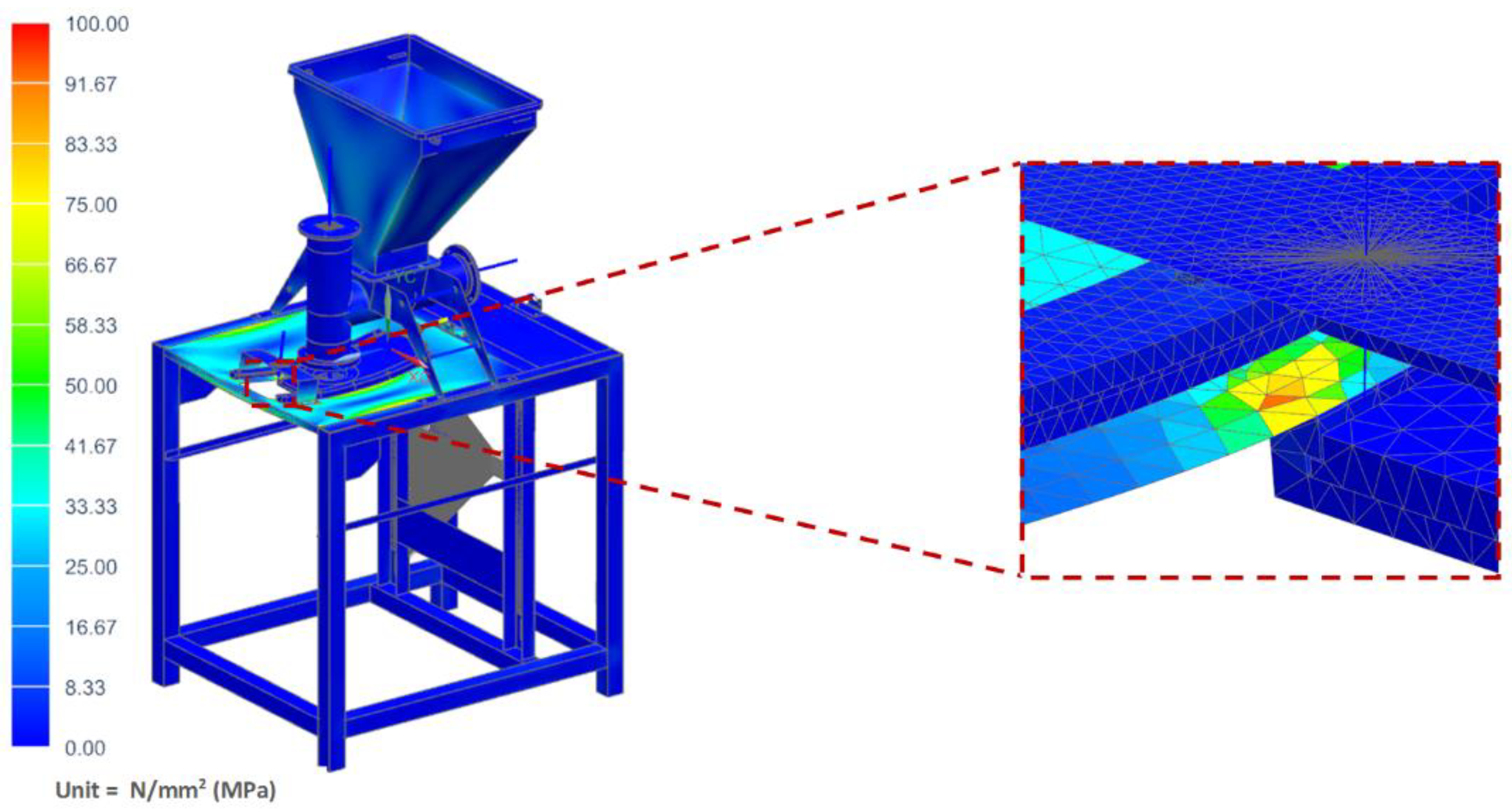

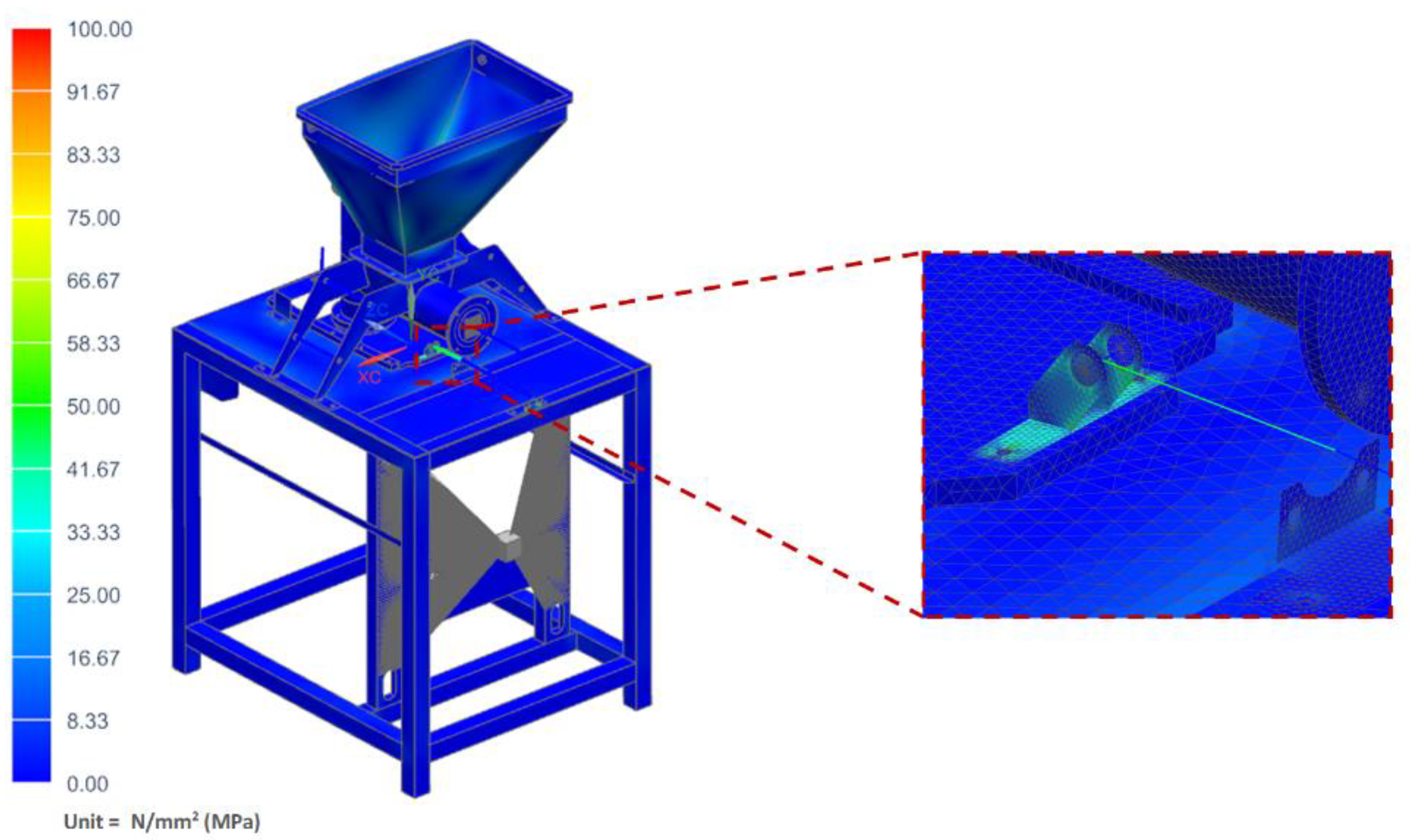
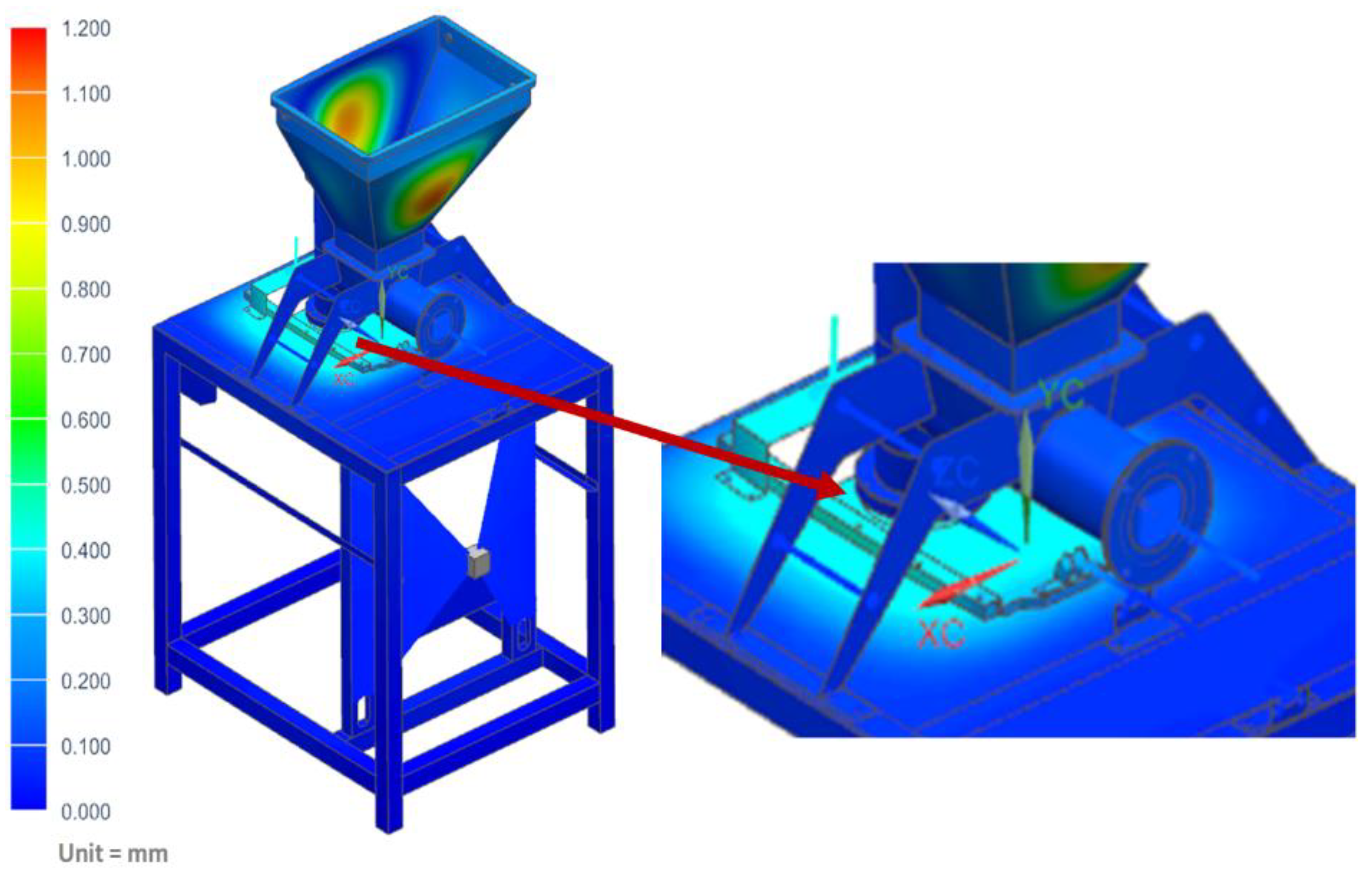

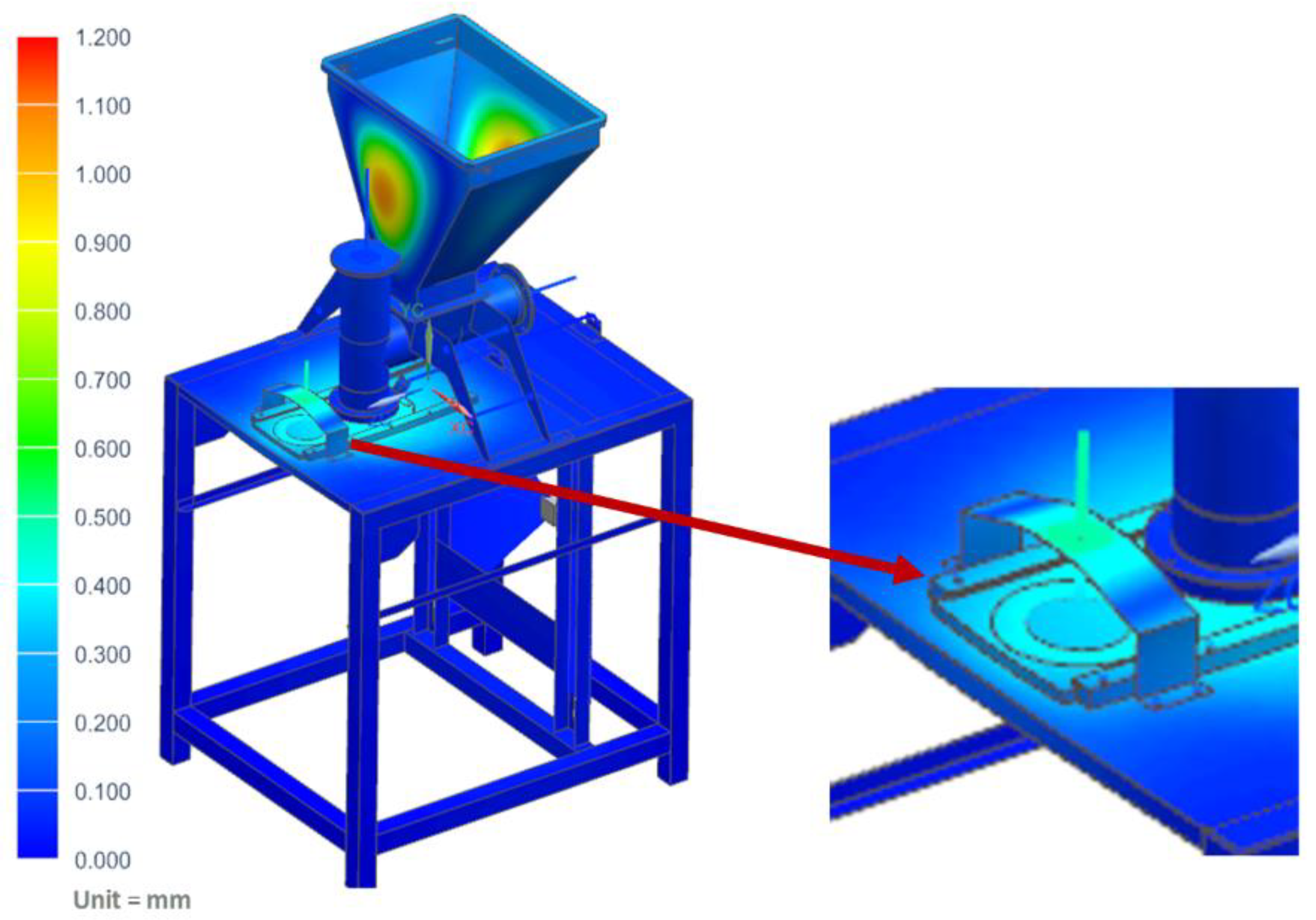
| Stress (MPa) | Displacement (mm) | Safety Index (Stress) | |
|---|---|---|---|
| Loading the structure with the vegetable mixture | 34.42 | 1.13 | 6.01 |
| Case 1 | 16.02 | 1.14 | 12.92 |
| Case 2 | 97.31 | 3.45 | 2.13 |
| Case 3 | 55.30 | 0.44 | 3.74 |
| Case 4 | 108.55 | 0.51 | 1.91 |
Publisher’s Note: MDPI stays neutral with regard to jurisdictional claims in published maps and institutional affiliations. |
© 2021 by the authors. Licensee MDPI, Basel, Switzerland. This article is an open access article distributed under the terms and conditions of the Creative Commons Attribution (CC BY) license (https://creativecommons.org/licenses/by/4.0/).
Share and Cite
Ignasiak, Ł.; Bieńczak, A.; Woźniak, P.; Kozłowicz, K.; Różyło, R.; Szczepaniak, J. Finite Element Simulation Tests of the Structural Strength of the Molding Module for Burger Production from Vegetable Outgrades. Materials 2021, 14, 6747. https://doi.org/10.3390/ma14226747
Ignasiak Ł, Bieńczak A, Woźniak P, Kozłowicz K, Różyło R, Szczepaniak J. Finite Element Simulation Tests of the Structural Strength of the Molding Module for Burger Production from Vegetable Outgrades. Materials. 2021; 14(22):6747. https://doi.org/10.3390/ma14226747
Chicago/Turabian StyleIgnasiak, Łukasz, Agata Bieńczak, Paweł Woźniak, Katarzyna Kozłowicz, Renata Różyło, and Jan Szczepaniak. 2021. "Finite Element Simulation Tests of the Structural Strength of the Molding Module for Burger Production from Vegetable Outgrades" Materials 14, no. 22: 6747. https://doi.org/10.3390/ma14226747
APA StyleIgnasiak, Ł., Bieńczak, A., Woźniak, P., Kozłowicz, K., Różyło, R., & Szczepaniak, J. (2021). Finite Element Simulation Tests of the Structural Strength of the Molding Module for Burger Production from Vegetable Outgrades. Materials, 14(22), 6747. https://doi.org/10.3390/ma14226747







